Opinion & Analysis
Two physical tests every golfer should ace

The golf swing is a reflection of how your body moves. If you are generally a tight and stiff person, your golf swing is most likely tight and stiff as well. Amateur golfers love to buy new golf equipment and spend money on swing lessons. Neither of these things are bad by any means, but golfers tend to neglect to work on the way their body moves to improve golf performance.
When I work with golfers, I run them through an extensive screening process to determine their physical limitations and how they manifest in their golf swing. The screening process includes looking at trunk rotational mobility, hip rotational mobility, shoulder mobility, core stability and strength, glute strength, forearm/wrist mobility, and more.
There are two specific tests that every golfer should ace. These two tests have been shown to be correlated to some pretty serious swing faults, causing a leakage of power, decreased accuracy, and poor consistency. These swing faults can also contribute to experiencing low back pain by placing excessive stress on the lumbar spine with each swing.
There is no new golf club out there that can promise you pain-free golf. There are few golf coaches out there that can coach you into a good position if your body physically cannot get into that position. Therefore, a high priority should be placed on improving your movement quality.
The Toe Touch Test

The test is simple: Can you touch your toes?
Keys to a passing score:
- Finger tips at least to your toes
- Knees stay straight
- Feet stay together
- No pain or discomfort
Failing the toe touch test can have many contributing factors. The most common limiting factors include:
- Limited hamstring flexibility and/or length
- Impaired lumbo-pelvic control
- Decreased core stability and strength
- Inadequate ability to shift weight posteriorly
- Increased neural tension
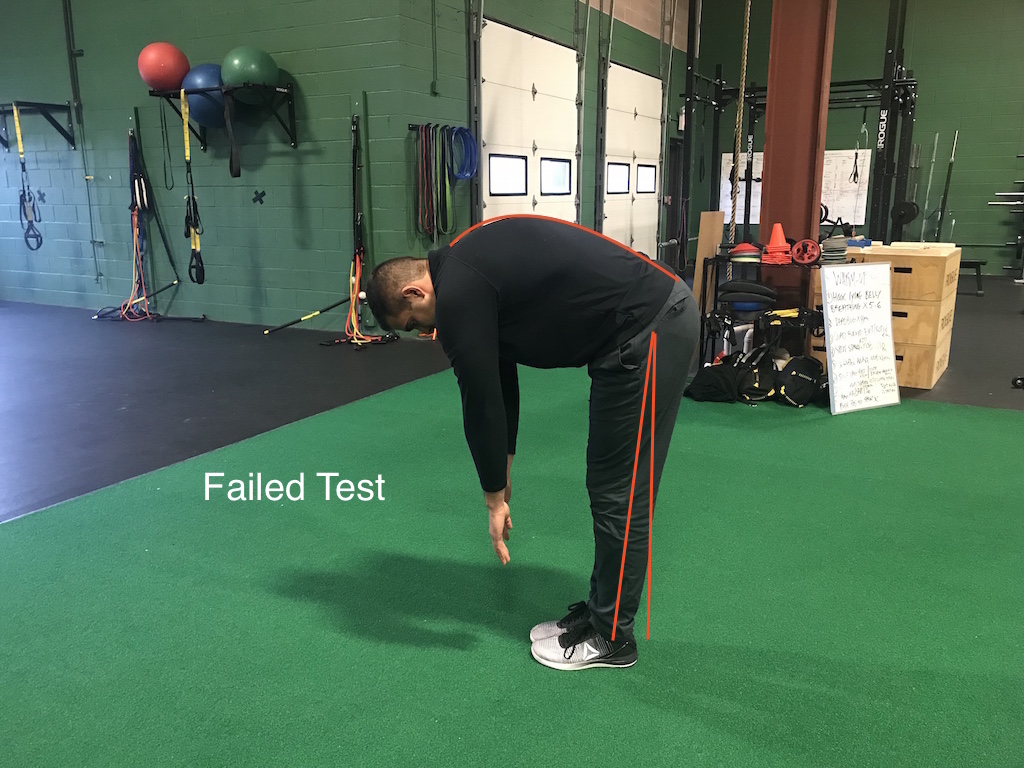
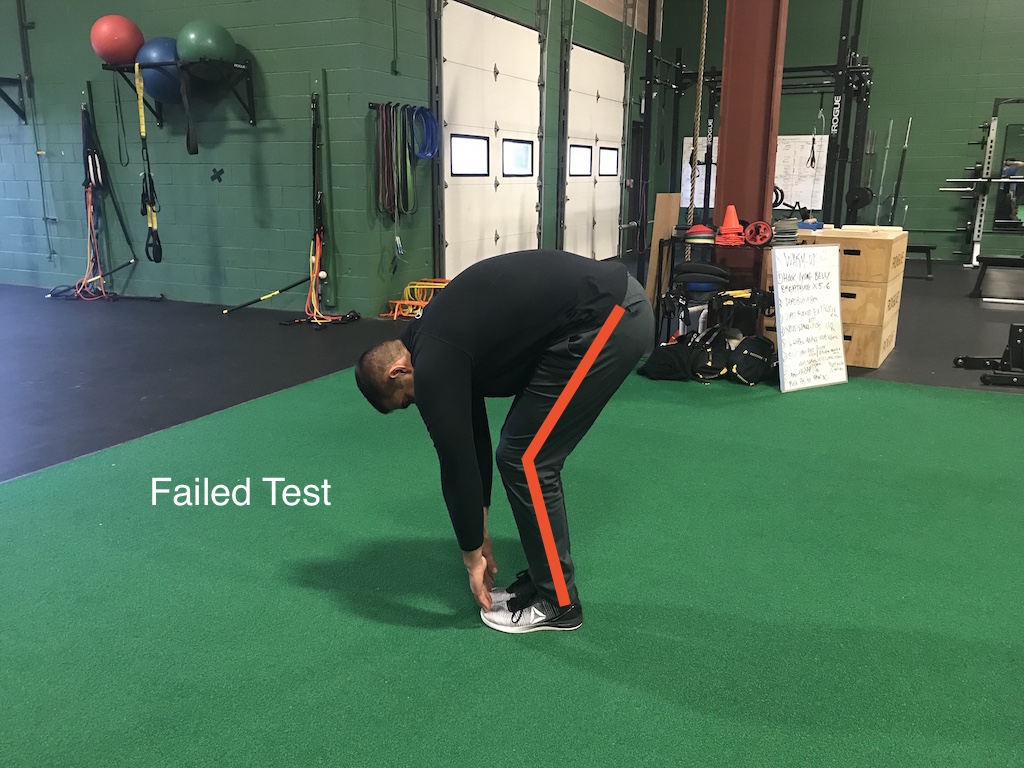
How Does This Impact Your Golf Game?
What we are essentially looking at is your ability to hip hinge. Most golfers set up in a bit of a hinged position, bending at the hips with their shoulders over the balls of their feet. In order to maintain posture throughout the swing, golfers must be able to maintain a hip-hinged position. If not, golfers will tend to lose posture and stand up in the backswing or in the downswing. This can lead to some serious compensations on the downswing, and make it difficult to generate clubhead speed, strike the ball well, and have consistent accuracy. A research study by Gulgin et al showed that a failed toe-touch test is strongly correlated to early extension in the downswing.
Single Leg Bridge Test
The single-leg bridge test looks at the ability of a golfer to extend through the hip by activating and maintain a contraction of the gluteus maximus muscle.
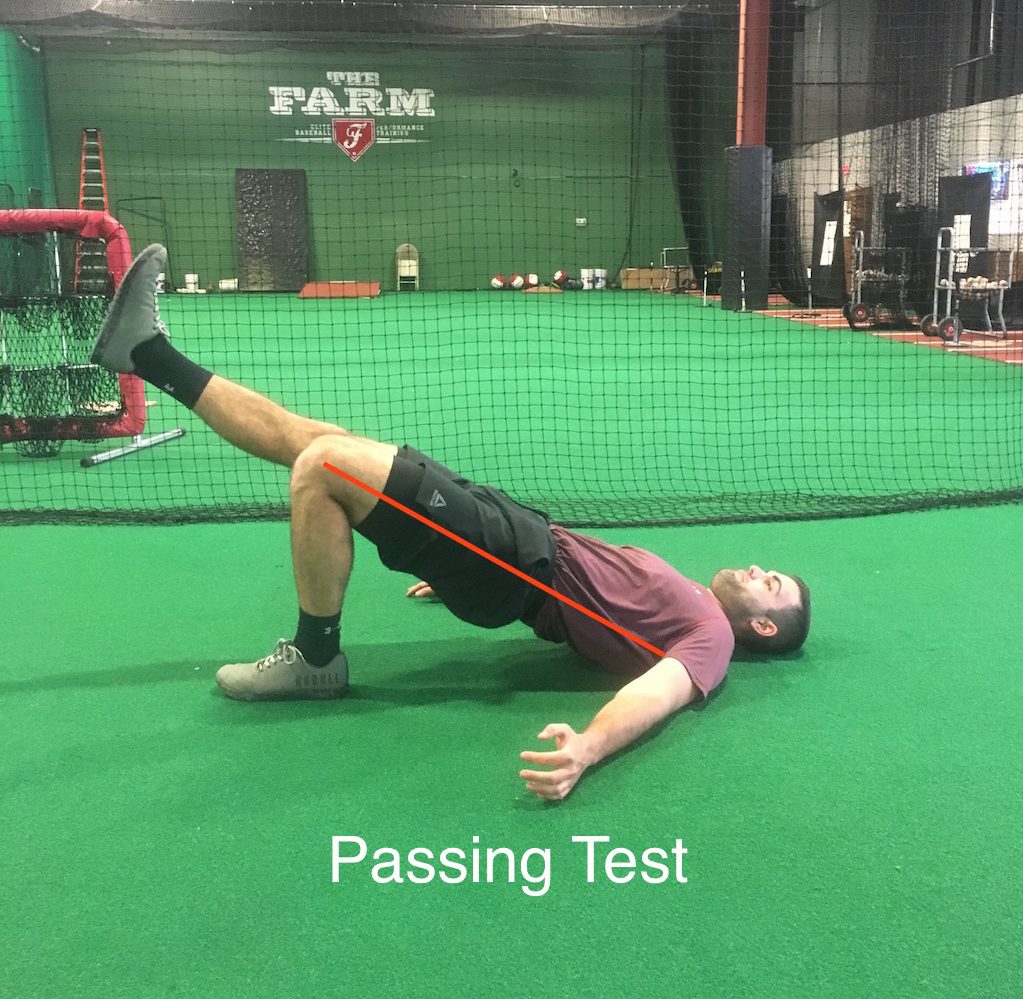
Keys to a Passing Score:
- Hips remain off the ground for 10-15 seconds
- Hips remain level to the ground
- Minimal compensation through the lower back
- No feeling of hamstring cramping
Failing the single leg bridge test can have many contributing factors. The most common limiting factors include:
- Lack of hip extension mobility
- Lack of hip extensor strength
- Motor control/ability to isolate glutes vs hamstrings
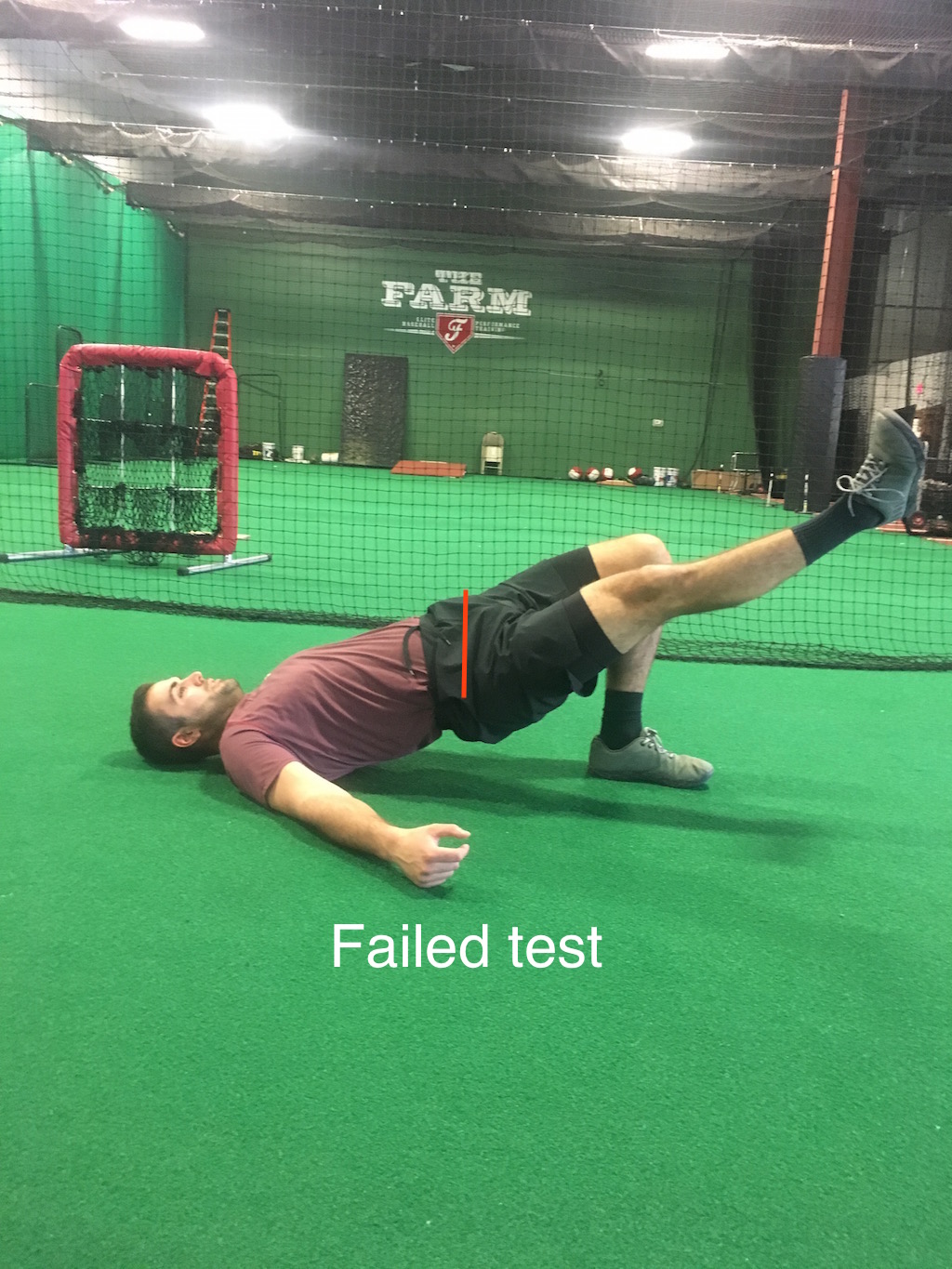
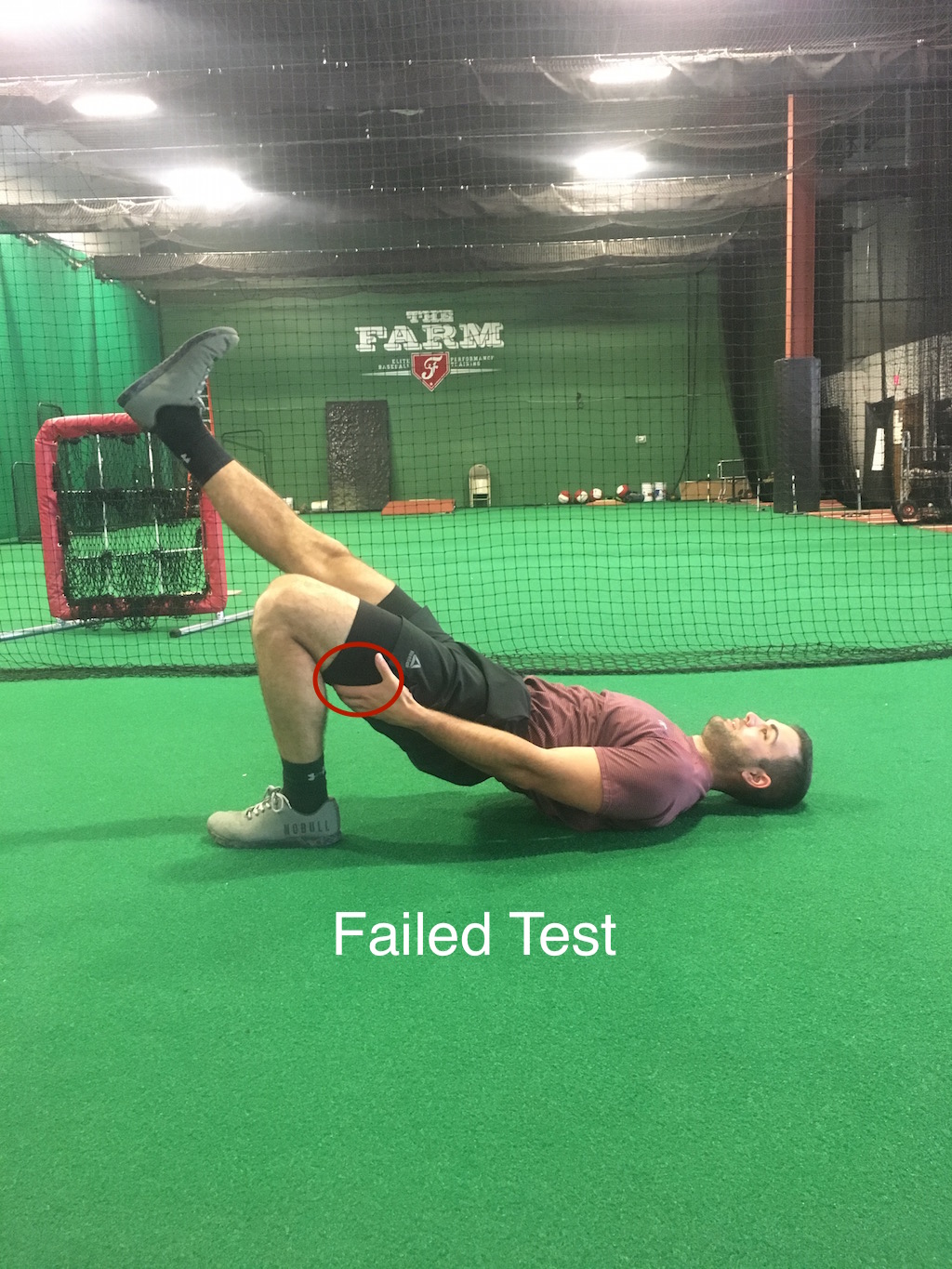
How Does This Impact Your Golf Game?
The glutes are probably the most important muscle group for golfers. Collectively, they act to extend the hip, stabilize the pelvis, and generate club head speed through pelvic rotation. Weakness or difficulty controlling the glutes has been shown to be correlated to early extension. Other faults that are related to weak or inactive glutes during the swing are swaying in the backswing and sliding through the downswing. Overall, the glutes enable a golfer to create power by stabilizing the pelvis and allowing for dissociation of the upper body and lower body. This helps generate torque and leads to increased club head speed.
How to Improve These Two Movements
Toe Touch/Hip Hinge
Touching your toes is such a basic movement that nearly every person was able to do at one point in their life. I often see middle-aged amateur golfers who work 40+ hours a week sitting at a desk fail the toe touch test. They certainly aren’t the only ones who fail this test, but I would say it is the majority in my experience.
In order to improve this movement, we need to work on a few things including hamstring flexibility, core control, and allowing for a posterior weight shift. The following drills utilize components of each of these principles to help a golfer improve their toe touch.
Single Leg Bridge/Glute Strength
Initiating and maintaining a contraction of your glute max muscle is another seemingly simple movement that I see many golfers fail. In most cases, it isn’t a pure strength issue that leads to a failed test. Typically, it is a combination of a lack of strength and difficulty isolating a contraction of the glutes.
That being said, we typically have to “retrain the brain” to use the glutes to produce the desired movement. The following exercises are meant to be a progression, so if you have difficulty with the first two, master those before moving on to the rest.

Perform these exercises 3-4 times per week for 2-4 weeks and you should start to see some noticeable improvement in these two screening scores.
Once the movement dysfunction has improved, it is time to start working on getting into better positions in your golf swing. Working with a golf instructor on improving your particular swing faults is the best way to see significant results. Again, you can’t put the cart before the horse when it comes to physical restrictions. Working with a golf coach will be most successful once the movement dysfunctions have already been cleared and your movement quality improves.
If you’ve been struggling to see any improvement in your golf game in the past, do yourself a favor and work on any current physical restrictions you may have. When golfers invest in their body first, they often find that they spend less money on lessons because they have more meaningful lessons and are able to make the changes the coach is asking them to. By improving your movement you will also begin to feel better and play better, more consistent golf!
- LIKE94
- LEGIT15
- WOW8
- LOL2
- IDHT1
- FLOP2
- OB0
- SHANK16
19th Hole
Vincenzi’s LIV Golf Singapore betting preview: Course specialist ready to thrive once again

After another strong showing in Australia, LIV Golf will head to Sentosa Golf Club in Singapore looking to build off of what was undoubtedly their best event to date.
Sentosa Golf Club sits on the southern tip of Singapore and is one of the most beautiful courses in the world. The course is more than just incredible scenically; it was also rated 55th in Golf Digest’s top-100 courses in 2022-2023 and has been consistently regarded as one of the best courses in Asia. Prior to being part of the LIV rotation, the course hosted the Singapore Open every year since 2005.
Sentosa Golf Club is a par 71 measuring 7,406 yards. The course will require precise ball striking and some length off the tee. It’s possible to go low due to the pristine conditions, but there are also plenty of hazards and difficult spots on the course that can bring double bogey into play in a hurry. The Bermudagrass greens are perfectly manicured, and the course has spent millions on the sub-air system to keep the greens rolling fast. I spoke to Asian Tour player, Travis Smyth, who described the greens as “the best [he’s] ever played.”
Davis Love III, who competed in a Singapore Open in 2019, also gushed over the condition of the golf course.
“I love the greens. They are fabulous,” the 21-time PGA Tour winner said.
Love III also spoke about other aspects of the golf course.
“The greens are great; the fairways are perfect. It is a wonderful course, and it’s tricky off the tee.”
“It’s a long golf course, and you get some long iron shots. It takes somebody hitting it great to hit every green even though they are big.”
As Love III said, the course can be difficult off the tee due to the length of the course and the trouble looming around every corner. It will take a terrific ball striking week to win at Sentosa Golf Club.
In his pre-tournament press conference last season, Phil Mickelson echoed many of the same sentiments.
“To play Sentosa effectively, you’re going to have a lot of shots from 160 to 210, a lot of full 6-, 7-, 8-iron shots, and you need to hit those really well and you need to drive the ball well.”
Golfers who excel from tee to green and can dial in their longer irons will have a massive advantage this week.
Stat Leaders at LIV Golf Adelaide:
Fairways Hit
1.) Louis Oosthuizen
2.) Anirban Lahiri
3.) Jon Rahm
4.) Brendan Steele
5.) Cameron Tringale
Greens in Regulation
1.) Brooks Koepka
2.) Brendan Steele
3.) Dean Burmester
4.) Cameron Tringale
5.) Anirban Lahiri
Birdies Made
1.) Brendan Steele
2.) Dean Burmester
3.) Thomas Pieters
4.) Patrick Reed
5.) Carlos Ortiz
LIV Golf Individual Standings:
1.) Joaquin Niemann
2.) Jon Rahm
3.) Dean Burmester
4.) Louis Oosthuizen
5.) Abraham Ancer
LIV Golf Team Standings:
1.) Crushers
2.) Legion XIII
3.) Torque
4.) Stinger GC
5.) Ripper GC
LIV Golf Singapore Picks
Sergio Garcia +3000 (DraftKings)
Sergio Garcia is no stranger to Sentosa Golf Club. The Spaniard won the Singapore Open in 2018 by five strokes and lost in a playoff at LIV Singapore last year to scorching hot Talor Gooch. Looking at the course setup, it’s no surprise that a player like Sergio has played incredible golf here. He’s long off the tee and is one of the better long iron players in the world when he’s in form. Garcia is also statistically a much better putter on Bermudagrass than he is on other putting surfaces. He’s putt extremely well on Sentosa’s incredibly pure green complexes.
This season, Garcia has two runner-up finishes, both of them being playoff losses. Both El Camaleon and Doral are courses he’s had success at in his career. The Spaniard is a player who plays well at his tracks, and Sentosa is one of them. I believe Sergio will get himself in the mix this week. Hopefully the third time is a charm in Singapore.
Paul Casey +3300 (FanDuel)
Paul Casey is in the midst of one of his best seasons in the five years or so. The results recently have been up and down, but he’s shown that when he’s on a golf course that suits his game, he’s amongst the contenders.
This season, Casey has finishes of T5 (LIV Las Vegas), T2 (LIV Hong Kong), and a 6th at the Singapore Classic on the DP World Tour. At his best, the Englishman is one of the best long iron players in the world, which makes him a strong fit for Sentosa. Despite being in poor form last season, he was able to fire a Sunday 63, which shows he can low here at the course.
It’s been three years since Casey has won a tournament (Omega Dubai Desert Classic in 2021), but he’s been one of the top players on LIV this season and I think he can get it done at some point this season.
Mito Pereira +5000 (Bet365)
Since Mito Pereira’s unfortunate demise at the 2022 PGA Championship, he’s been extremely inconsistent. However, over the past few months, the Chilean has played well on the International Series as well as his most recent LIV start. Mito finished 8th at LIV Adelaide, which was his best LIV finish this season.
Last year, Pereira finished 5th at LIV Singapore, shooting fantastic rounds of 67-66-66. It makes sense why Mito would like Sentosa, as preeminent ball strikers tend to rise to the challenge of the golf course. He’s a great long iron player who is long and straight off the tee.
Mito has some experience playing in Asia and is one of the most talented players on LIV who’s yet to get in the winner’s circle. I have questions about whether or not he can come through once in contention, but if he gets there, I’m happy to roll the dice.
Andy Ogletree +15000 (DraftKings)
Andy Ogletree is a player I expected to have a strong 2024 but struggled early in his first full season on LIV. After failing to crack the top-25 in any LIV event this year, the former U.S. Amateur champion finally figured things out, finished in a tie for 3rd at LIV Adelaide.
Ogletree should be incredible comfortable playing in Singapore. He won the International Series Qatar last year and finished T3 at the International Series Singapore. The 26-year-old was arguably the best player on the Asian Tour in 2023 and has been fantastic in the continent over the past 18 months.
If Ogletree has indeed found form, he looks to be an amazing value at triple-digit odds.
- LIKE3
- LEGIT3
- WOW1
- LOL2
- IDHT0
- FLOP2
- OB0
- SHANK0
Opinion & Analysis
Ryan: Lessons from the worst golf instructor in America

In Tampa, there is a golf course that boasts carts that do not work, a water range, and a group of players none of which have any chance to break 80. The course is overseen by a staff of crusty men who have succeeded at nothing in life but ending up at the worst-run course in America. However, this place is no failure. With several other local courses going out of business — and boasting outstanding greens — the place is booked full.
While I came for the great greens, I stayed to watch our resident instructor; a poor-tempered, method teacher who caters to the hopeless. At first, it was simply hilarious. However, after months of listening and watching, something clicked. I realized I had a front-row seat to the worst golf instructor in America.
Here are some of my key takeaways.
Method Teacher
It is widely accepted that there are three types of golf instructors: system teachers, non-system teachers, and method teachers. Method teachers prescribe the same antidote for each student based on a preamble which teachers can learn in a couple day certification.
Method teaching allows anyone to be certified. This process caters to the lowest caliber instructor, creating the illusion of competency. This empowers these underqualified instructors with the moniker of “certified” to prey on the innocent and uninformed.
The Cult of Stack and Jilt
The Stack and Tilt website proudly boasts, “A golfer swings his hands inward in the backswing as opposed to straight back to 1) create power, similar to a field goal kicker moving his leg in an arc and 2) to promote a swing that is in-to-out, which produces a draw (and eliminates a slice).”
Now, let me tell you something, there is this law of the universe which says “energy can either be created or destroyed,” so either these guys are defying physics or they have no idea what they are taking about. Further, the idea that the first move of the backswing determines impact is conjecture with a splash of utter fantasy.
These are the pontifications of a method — a set of prescriptions applied to everyone with the hope of some success through the placebo effect. It is one thing for a naive student to believe, for a golf instructor to drink and then dispel this Kool-Aid is malpractice.
Fooled by Randomness
In flipping a coin, or even a March Madness bet, there is a 50-50 chance of success. In golf, especially for new players, results are asymmetric. Simply put: Anything can happen. The problem is that when bad instructors work with high handicappers, each and every shot gets its own diagnosis and prescription. Soon the student is overwhelmed.
Now here’s the sinister thing: The overwhelming information is by design. In this case, the coach is not trying to make you better, they are trying to make you reliant on them for information. A quasi Stockholm syndrome of codependency.
Practice
One of the most important scientists of the 20th century was Ivan Pavlov. As you might recall, he found that animals, including humans, could be conditioned into biological responses. In golf, the idea of practice has made millions of hackers salivate that they are one lesson or practice session from “the secret.”
Sunk Cost
The idea for the worst golf instructor is to create control and dependency so that clients ignore the sunk cost of not getting better. Instead, they are held hostage by the idea that they are one lesson or tip away from unlocking their potential.
Cliches
Cliches have the effect of terminating thoughts. However, they are the weapon of choice for this instructor. Add some hyperbole and students actually get no information. As a result, these players couldn’t play golf. When they did, they had no real scheme. With no idea what they are doing, they would descend into a spiral of no idea what to do, bad results, lower confidence, and running back to the lesson tee from more cliches.
The fact is that poor instruction is about conditioning players to become reliant members of your cult. To take away autonomy. To use practice as a form of control. To sell more golf lessons not by making people better but through the guise that without the teacher, the student can never reach their full potential. All under the umbrella of being “certified” (in a 2-day course!) and a melee of cliches.
This of course is not just happening at my muni but is a systemic problem around the country and around the world, the consequences of which are giving people a great reason to stop playing golf. But hey, at least it’s selling a lot of golf balls…
- LIKE17
- LEGIT2
- WOW0
- LOL4
- IDHT1
- FLOP4
- OB1
- SHANK23
19th Hole
Vincenzi’s 2024 Zurich Classic of New Orleans betting preview

The PGA TOUR heads to New Orleans to play the 2023 Zurich Classic of New Orleans. In a welcome change from the usual stroke play, the Zurich Classic is a team event. On Thursday and Saturday, the teams play best ball, and on Friday and Sunday the teams play alternate shot.
TPC Louisiana is a par 72 that measures 7,425 yards. The course features some short par 4s and plenty of water and bunkers, which makes for a lot of exciting risk/reward scenarios for competitors. Pete Dye designed the course in 2004 specifically for the Zurich Classic, although the event didn’t make its debut until 2007 because of Hurricane Katrina.
Coming off of the Masters and a signature event in consecutive weeks, the field this week is a step down, and understandably so. Many of the world’s top players will be using this time to rest after a busy stretch.
However, there are some interesting teams this season with some stars making surprise appearances in the team event. Some notable teams include Patrick Cantlay and Xander Schauffele, Rory McIlroy and Shane Lowry, Collin Morikawa and Kurt Kitayama, Will Zalatoris and Sahith Theegala as well as a few Canadian teams, Nick Taylor and Adam Hadwin and Taylor Pendrith and Corey Conners.
Past Winners at TPC Louisiana
- 2023: Riley/Hardy (-30)
- 2022: Cantlay/Schauffele (-29)
- 2021: Leishman/Smith (-20)
- 2019: Palmer/Rahm (-26)
- 2018: Horschel/Piercy (-22)
- 2017: Blixt/Smith (-27)
2024 Zurich Classic of New Orleans Picks
Tom Hoge/Maverick McNealy +2500 (DraftKings)
Tom Hoge is coming off of a solid T18 finish at the RBC Heritage and finished T13 at last year’s Zurich Classic alongside Harris English.
This season, Hoge is having one of his best years on Tour in terms of Strokes Gained: Approach. In his last 24 rounds, the only player to top him on the category is Scottie Scheffler. Hoge has been solid on Pete Dye designs, ranking 28th in the field over his past 36 rounds.
McNealy is also having a solid season. He’s finished T6 at the Waste Management Phoenix Open and T9 at the PLAYERS Championship. He recently started working with world renowned swing coach, Butch Harmon, and its seemingly paid dividends in 2024.
Keith Mitchell/Joel Dahmen +4000 (DraftKings)
Keith Mitchell is having a fantastic season, finishing in the top-20 of five of his past seven starts on Tour. Most recently, Mitchell finished T14 at the Valero Texas Open and gained a whopping 6.0 strokes off the tee. He finished 6th at last year’s Zurich Classic.
Joel Dahmen is having a resurgent year and has been dialed in with his irons. He also has a T11 finish at the PLAYERS Championship at TPC Sawgrass which is another Pete Dye track. With Mitchell’s length and Dahmen’s ability to put it close with his short irons, the Mitchell/Dahmen combination will be dangerous this week.
Taylor Moore/Matt NeSmith +6500 (DraftKings)
Taylor Moore has quickly developed into one of the more consistent players on Tour. He’s finished in the top-20 in three of his past four starts, including a very impressive showing at The Masters, finishing T20. He’s also finished T4 at this event in consecutive seasons alongside Matt NeSmith.
NeSmith isn’t having a great 2024, but has seemed to elevate his game in this format. He finished T26 at Pete Dye’s TPC Sawgrass, which gives the 30-year-old something to build off of. NeSmith is also a great putter on Bermudagrass, which could help elevate Moore’s ball striking prowess.
- LIKE8
- LEGIT3
- WOW1
- LOL1
- IDHT0
- FLOP3
- OB1
- SHANK2
-

 19th Hole2 weeks ago
19th Hole2 weeks agoJustin Thomas on the equipment choice of Scottie Scheffler that he thinks is ‘weird’
-

 19th Hole2 weeks ago
19th Hole2 weeks ago‘Absolutely crazy’ – Major champ lays into Patrick Cantlay over his decision on final hole of RBC Heritage
-

 19th Hole3 weeks ago
19th Hole3 weeks agoReport: LIV Golf identifies latest star name they hope to sign to breakaway tour
-

 19th Hole3 weeks ago
19th Hole3 weeks agoNeal Shipley presser ends in awkward fashion after reporter claims Tiger handed him note on 8th fairway
-

 19th Hole3 weeks ago
19th Hole3 weeks agoBrandel Chamblee has ‘no doubt’ who started the McIlroy/LIV rumor and why
-

 19th Hole1 week ago
19th Hole1 week agoLET pro gives detailed financial breakdown of first week on tour…and the net result may shock you
-

 Equipment3 weeks ago
Equipment3 weeks agoJason Day on his recent switch into Srixon ZX5 and ZX7 Mk II irons
-

 19th Hole4 days ago
19th Hole4 days agoGary Player claims this is what ‘completely ruined’ Tiger Woods’ career



















TommyMaysHayes
Jul 5, 2018 at 3:18 am
Mike,
Kudos for presenting so.e useful metrics and solutions. Also for putting up with some snide comments with good humor. I hope you aren’t dissuaded from future contributions!
Mike Scaduto
Jul 5, 2018 at 7:20 am
Thank you Tommy! i will definitely be contributing more in the future!
Frank Xavier
Jul 3, 2018 at 8:00 pm
Thank you for the excellent article. You have got to the core of many/most golfers swing issues in a very targeted, thoughtful and constructive manner. Look forward to more like this.
Mike Scaduto
Jul 5, 2018 at 7:21 am
Thank you Frank! All swing “issues” are typically multi-factorial but I think working on movement quality is a fantastic place to start, especially for the amateur golfer.
JJD
Jul 3, 2018 at 7:10 pm
Doing a simple 5×5 program (my current favorite is ICF 5×5 [side note: blaha is an idiot but this program that he essentially stole is solid]) is a great way to be in shape for golf. I’m not a subscriber to the philosophy that amateurs need to do “sports-specific” programs. In fact, I think most would benefit more so from doing a generalized total-body program when considering the lack of any kind of fitness of the majority of the public.
Mike Scaduto
Jul 5, 2018 at 7:24 am
JJD– I totally agree. The majority of amateur golfers would see tremendous benefit from a “general” strength and conditioning program. Focusing on movement quality, strength, power, speed, agility, etc is a great way to feel better and improve your game. Exercises in the gym do not need to mimic the golf swing, sticking to fundamental movement patterns is typically the way to go for amateurs!
Bob
Jul 2, 2018 at 1:21 am
the test was failed when you chose to wear high black socks to the gym… My God what were you thinking.
Mike Scaduto
Jul 2, 2018 at 2:50 pm
Thanks for the feedback! I’ll be sure to where socks that you approve next time!
Jamie
Jul 1, 2018 at 4:35 pm
So golf is doomed then. Tip to the author: Suggest these exercises as a means of making an athletic and comfortable swing rather than saying someone will never succeed at the game unless …..
ogo
Jul 1, 2018 at 4:40 pm
Yup… 99.5% of all 50 million golfers worldwide will fail these tests. Why? Because maintaining fitness ain’t ffuunn …. 😛
Mike Scaduto
Jul 2, 2018 at 8:14 pm
Thanks for your feedback. I’m sorry that you didn’t find this article helpful.
Mike Scaduto
Jul 5, 2018 at 10:28 am
OGO– playing better golf is surely a lot more fun than struggling around the course though 🙂
Mike Scaduto
Jul 2, 2018 at 8:05 pm
Jamie– thanks for the comment. I’m sorry that that was your take away from this article, it wasn’t my intention.
The purpose of the article was to highlight that physical restrictions may impact your golf swing. I’m not sure where I made it seem like golf is doomed because of this? Plenty of golfers can be successful even if they can’t touch their toes or hold a glute bridge. There are also plenty (maybe even more) golfers who are trying to improve their game but are frustrated by their progress. My intention was to show that for some people, working on their movement quality may lead to more meaningful improvement and better play.
I’d be happy to discuss this further if you have any questions!
Mike
Sean
Jul 1, 2018 at 3:57 pm
I know scratch golfers that can’t do any of those things
Ryan
Jul 1, 2018 at 4:03 pm
I know about 5 guys that cant do either and shoot par easily
Mike Scaduto
Jul 2, 2018 at 8:13 pm
Sean–
No doubt. I’m sure there are millions of golfers who are scratch or better who can’t pass these tests. These tests are in no way meant to be predictive of a golfers handicap or skill level.
The article is written for golfers who are looking to improve their game but are frustrated by their lack of progress. The goal was to educate golfers that working on movement quality can have a positive impact on their game. Also, even scratch golfers (and professional golfers) are constantly trying to get better. This may be a great way for these great golfers to improve their game and take it to the next level.
I’d love to hear your opinion on this. I think we could have a great discussion on this.
David
Jul 12, 2018 at 12:11 pm
That would be me. LOL
Jay
Jul 1, 2018 at 12:41 pm
Mike, I haven’t been able to touch my toes since forever. I think I couldn’t do it even back in high school.
Do you think the drill will help, or should I start taking Yoga classes to increase basic flexibility first instead?
Mike Scaduto
Jul 2, 2018 at 8:25 pm
Hey Jay– Thank you for the comment.
Without knowing much about you, I would suggest that you find a qualified physical therapist, etc who can fully assess your particular situation and come up with a game plan tailored to your needs.
I’d be happy to connect via email or phone if you’d like to discuss this further!
-Mike